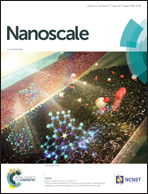Promoting power density by cleaving LiCoO2 into nano-flake structure for high performance supercapacitor†
Abstract
LiCoO2 (LCO) usually can deliver high energy density but low power density in Li-ion batteries (LIBs). Whether LCO could be used as electrode material for high-performance supercapacitors is dependent on promoting its power density. Owing to Faradaic redox reactions taking place on its surfaces or inside crystals through ion intercalation/deintercalation from the surfaces, increasing the specific area of LCO is a key factor to promote its rate capability. Herein, we report a facile strategy to prepare LCO nano-flakes with high specific area exceeding that of currently used micro-scale particles in LIBs. LCO as a nano-flake structure is expected to have a high fraction of Li atom exposure, which benefits fast redox reactions taking place on the surfaces. An LCO-based electrode exhibits an excellent specific capacitance of 581.3 F g−1 at 0.5 A g−1, high power density of 2262 W kg−1 at an energy density of 41.0 Wh kg−1, and good cycling stability (83.9% capacitance retention at 6 A g−1 after 2000 cycles) in LiCl aqueous electrolyte. Faradaic redox behaviors have been analyzed, indicating an ideal diffusion-controlled process. Moreover, a full solid-state symmetric supercapacitor is assembled using LCO nano-flake-based electrodes, which presents good performance with light weight and flexibility. Impressively, three charged supercapacitors in series can light 100 green light emitting diodes for 14 min. LCO in nano-flake structure form with high power density could be an excellent material for superior supercapacitors.



 Please wait while we load your content...
Please wait while we load your content...